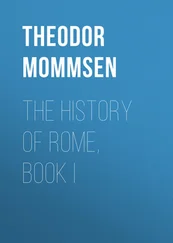Theodor Mommsen - The History of Rome. Book III
Здесь есть возможность читать онлайн «Theodor Mommsen - The History of Rome. Book III» весь текст электронной книги совершенно бесплатно (целиком полную версию без сокращений). В некоторых случаях можно слушать аудио, скачать через торрент в формате fb2 и присутствует краткое содержание. Жанр: История, Культурология, на английском языке. Описание произведения, (предисловие) а так же отзывы посетителей доступны на портале библиотеки ЛибКат.
- Название:The History of Rome. Book III
- Автор:
- Жанр:
- Год:неизвестен
- ISBN:нет данных
- Рейтинг книги:5 / 5. Голосов: 1
-
Избранное:Добавить в избранное
- Отзывы:
-
Ваша оценка:
- 100
- 1
- 2
- 3
- 4
- 5
The History of Rome. Book III: краткое содержание, описание и аннотация
Предлагаем к чтению аннотацию, описание, краткое содержание или предисловие (зависит от того, что написал сам автор книги «The History of Rome. Book III»). Если вы не нашли необходимую информацию о книге — напишите в комментариях, мы постараемся отыскать её.
The History of Rome. Book III — читать онлайн бесплатно полную книгу (весь текст) целиком
Ниже представлен текст книги, разбитый по страницам. Система сохранения места последней прочитанной страницы, позволяет с удобством читать онлайн бесплатно книгу «The History of Rome. Book III», без необходимости каждый раз заново искать на чём Вы остановились. Поставьте закладку, и сможете в любой момент перейти на страницу, на которой закончили чтение.
Интервал:
Закладка:
10.III. I. The Carthaginian Dominion in Africa.
11.The medium price of grain in the capital may be assumed at least for the seventh and eighth centuries of Rome at one denarius for the Roman modius , or 2 shillings 8 pence per bushel of wheat, for which there is now paid (according to the average of the prices in the provinces of Brandenburg and Pomerania from 1816 to 1841) about 3 shillings 5 pence. Whether this not very considerable difference between the Roman and the modern prices depends on a rise in the value of corn or on a fall in the value of silver, can hardly be decided. It is very doubtful, perhaps, whether in the Rome of this and of later times the prices of corn really fluctuated more than is the case in modern times. If we compare prices like those quoted above, of 4 pence and 5 pence for the bushel and a half, with those of the worst times of war-dearth and famine - such as in the second Punic war when the same quantity rose to 9 shillings 7 pence (1 medimnus = 15 drachmae ; Polyb. ix. 44), in the civil war to 19 shillings 2 pence (1 modius = 5 denarii ; Cic. Verr. iii. 92, 214), in the great dearth under Augustus, even to 21 shillings 3 pence (5 modii =27 1/2 denarii ; Euseb. Chron. p. Chr. 7, Scal.) - the difference is indeed immense; but such extreme cases are but little instructive, and might in either direction be found recurring under the like conditions at the present day.
12.II. VIII. Farming of Estates.
13.Accordingly Cato calls the two estates, which he describes, summarily "olive-plantation" ( olivetum ) and "vineyard" ( vinea ), although not wine and oil merely, but grain also and other products were cultivated there. If indeed the 800 culei , for which the possessor of the vineyard is directed to provide himself with casks (11), formed the maximum of a year's vintage, the whole of the 100 jugera must have been planted with vines, because a produce of 8 culei per jugerum was almost unprecedented (Colum. iii. 3); but Varro (i. 22) understood, and evidently with reason, the statement to apply to the case of the possessor of a vineyard who found it necessary to make the new vintage before he had sold the old.
14.That the Roman landlord made on an average 6 per cent from his capital, may be inferred from Columella, iii. 3, 9. We have a more precise estimate of the expense and produce only in the case of the vine yard, for which Columella gives the following calculation of the cost per jugerum :
Price of the ground: 1000 sesterces.
Price of the slaves who work it: 1143
(proportion to jugerum )
Vines and stakes: 2000
Loss of interest during the first two years: 497
Total: 4640 sesterces = 47 pounds.
He calculates the produce as at any rate 60 amphorae , worth at least 900 sesterces (9 pounds), which would thus represent a return of 17 per cent. But this is somewhat illusory, as, apart from bad harvests, the cost of gathering in the produce (III. XII. Spirit of the System), and the expenses of the maintenance of the vines, stakes, and slaves, are omitted from the estimate.
The gross produce of meadow, pasture, and forest is estimated by the same agricultural writer as, at most, 100 sesterces per jugerum , and that of corn land as less rather than more: in fact, the average return of 25 modii of wheat per jugerum gives, according to the average price in the capital of 1 denarius per modius , not more than 100 sesterces for the gross proceeds, and at the seat of production the price must have been still lower. Varro (iii. 2) reckons as a good ordinary gross return for a larger estate 150 sesterces per jugerum . Estimates of the corresponding expense have not reached us: as a matter of course, the management in this instance cost much less than in that of a vineyard.
All these statements, moreover, date from a century or more after Gate's death. From him we have only the general statement that the breeding of cattle yielded a better return than agriculture (ap. Cicero, De Off. ii. 25, 89; Colum. vi. praef. 4, comp. ii. 16, 2; Plin. H. N. xviii. 5, 30; Plutarch, Cato, 21); which of course is not meant to imply that it was everywhere advisable to convert arable land into pasture, but is to be understood relatively as signifying that the capital invested in the rearing of flocks and herds on mountain pastures and other suitable pasture-land yielded, as compared with capital invested in cultivating Suitable corn land, a higher interest. Perhaps the circumstance has been also taken into account in the calculation, that the want of energy and intelligence in the landlord operates far less injuriously in the case of pasture-land than in the highly-developed culture of the vine and olive. On an arable estate, according to Cato, the returns of the soil stood as follows in a descending series: 1 - vineyard; 2 - vegetable garden; 3 - osier copse, which yielded a large return in consequence of the culture of the vine; 4 - olive plantation; 5 - meadow yielding hay; 6 - corn fields; 7 - copse; 8 - wood for felling; 9 - oak forest for forage to the cattle; all of which nine elements enter into the scheme of husbandry for Cato's model estates.
The higher net return of the culture of the vine as compared with that of corn is attested also by the fact, that under the award pronounced in the arbitration between the city of Genua and the villages tributary to it in 637 the city received a sixth of wine, and a twentieth of grain, as quitrent.
15.III. XII. Spirit of the System.
16.III. XI. As to the Management of the Finances.
17.The industrial importance of the Roman cloth-making is evident from the remarkable part which is played by the fullers in Roman comedy. The profitable nature of the fullers' pits is attested by Cato (ap. Plutarch, Cat 21).
18.III. III. Organization of the Provinces.
19.III. III. Property.
20.III. VII. The State of Culture in Spain.
21.III. I. Comparison between Carthage and Rome.
22.III. VI. Pressure of the War.
23.There were in the treasury 17,410 Roman pounds of gold, 22,070 pounds of uncoined, and 18,230 pounds of coined, silver. The legal ratio of gold to silver was: 1 pound of gold = 4000 sesterces, or 1: 11.91.
24.On this was based the actionable character of contracts of buying, hiring, and partnership, and, in general, the whole system of non-formal actionable contracts.
25.The chief passage as to this point is the fragment of Cato in Gellius, xiv. 2. In the case of the obligatio litteris also, i. e. a claim based solely on the entry of a debt in the account-book of the creditor, this legal regard paid to the personal credibility of the party, even where his testimony in his own cause is concerned, affords the key of explanation; and hence it happened that in later times, when this mercantile repute had vanished from Roman life, the obligatio litteris , while not exactly abolished, fell of itself into desuetude.
26.In the remarkable model contract given by Cato (141) for the letting of the olive harvest, there is the following paragraph: "None [of the persons desirous to contract on the occasion of letting] shall withdraw, for the sake of causing the gathering and pressing of the olives to be let at a dearer rate; except when [the joint bidder] immediately names [the other bidder] as his partner. If this rule shall appear to have been infringed, all the partners [of the company with which the contract has been concluded] shall, if desired by the landlord or the overseer appointed by him, take an oath [that they have not conspired in this way to prevent competition]. If they do not take the oath, the stipulated price is not to be paid". It is tacitly assumed that the contract is taken by a company, not by an individual capitalist.
Читать дальшеИнтервал:
Закладка:
Похожие книги на «The History of Rome. Book III»
Представляем Вашему вниманию похожие книги на «The History of Rome. Book III» списком для выбора. Мы отобрали схожую по названию и смыслу литературу в надежде предоставить читателям больше вариантов отыскать новые, интересные, ещё непрочитанные произведения.
Обсуждение, отзывы о книге «The History of Rome. Book III» и просто собственные мнения читателей. Оставьте ваши комментарии, напишите, что Вы думаете о произведении, его смысле или главных героях. Укажите что конкретно понравилось, а что нет, и почему Вы так считаете.








